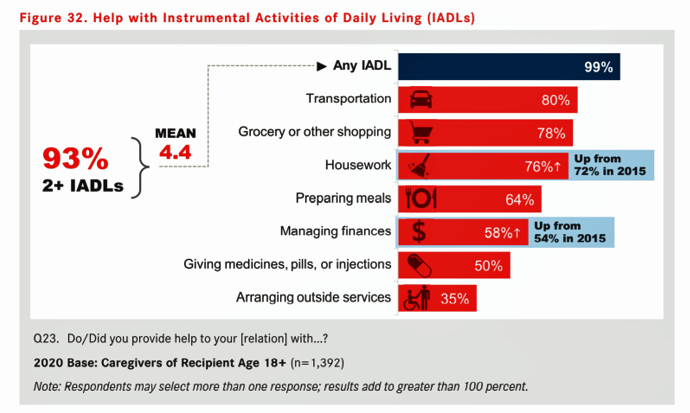 We are all caregivers now. The COVID-19 pandemic has touched and continues to re-shape our daily lives. One reality that the coronavirus era has revealed is that caregiving is a daily life-flow for everyone around the world. In the U.S., this has particularly acute impacts — physical, emotional, and financial.
We are all caregivers now. The COVID-19 pandemic has touched and continues to re-shape our daily lives. One reality that the coronavirus era has revealed is that caregiving is a daily life-flow for everyone around the world. In the U.S., this has particularly acute impacts — physical, emotional, and financial.
The 2020 AARP report on caregiving was published this month, and the survey research into caregivers uncovered fresh insights about caregivers’ demographics, financial stressors, and intensity of tasks both in volume and time. In addition, more caregivers are looking for and turning to technology to help them hack effort, time and tasks as caregiving commitments grow both for physical needs and financial.
 Check out the bar chart identifying the instrumental activities of daily living (IADLs) which go beyond traditional “ADLs” — the activities of daily living like feeding, toileting, personal hygiene and the like.
Check out the bar chart identifying the instrumental activities of daily living (IADLs) which go beyond traditional “ADLs” — the activities of daily living like feeding, toileting, personal hygiene and the like.
I look to these IADLs as personal social determinants, or barriers, to health. The growth of Medicare Advantage has led to more such services to be tailored to the individual plan member. The era of COVID has ushered in even more need and demand for these kinds of programs, necessitating the collaboration of health plans, providers, and community-based touch points like grocery stores, food delivery services, banks and household service providers,
I explain these trends in a post I wrote for Medecision’s Liberate Health blog, titled Big Hearts: How Caregiving Has Changed in America. Do click on the link and read the insights I wanted to share with Medecision’s stakeholders – health plans, health systems, and the entire health/care ecosystem.





 Interviewed live on BNN Bloomberg (Canada) on the market for GLP-1 drugs for weight loss and their impact on both the health care system and consumer goods and services -- notably, food, nutrition, retail health, gyms, and other sectors.
Interviewed live on BNN Bloomberg (Canada) on the market for GLP-1 drugs for weight loss and their impact on both the health care system and consumer goods and services -- notably, food, nutrition, retail health, gyms, and other sectors. Thank you, Feedspot, for
Thank you, Feedspot, for  As you may know, I have been splitting work- and living-time between the U.S. and the E.U., most recently living in and working from Brussels. In the month of September 2024, I'll be splitting time between London and other parts of the U.K., and Italy where I'll be working with clients on consumer health, self-care and home care focused on food-as-medicine, digital health, business and scenario planning for the future...
As you may know, I have been splitting work- and living-time between the U.S. and the E.U., most recently living in and working from Brussels. In the month of September 2024, I'll be splitting time between London and other parts of the U.K., and Italy where I'll be working with clients on consumer health, self-care and home care focused on food-as-medicine, digital health, business and scenario planning for the future...